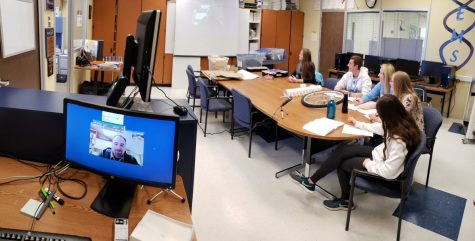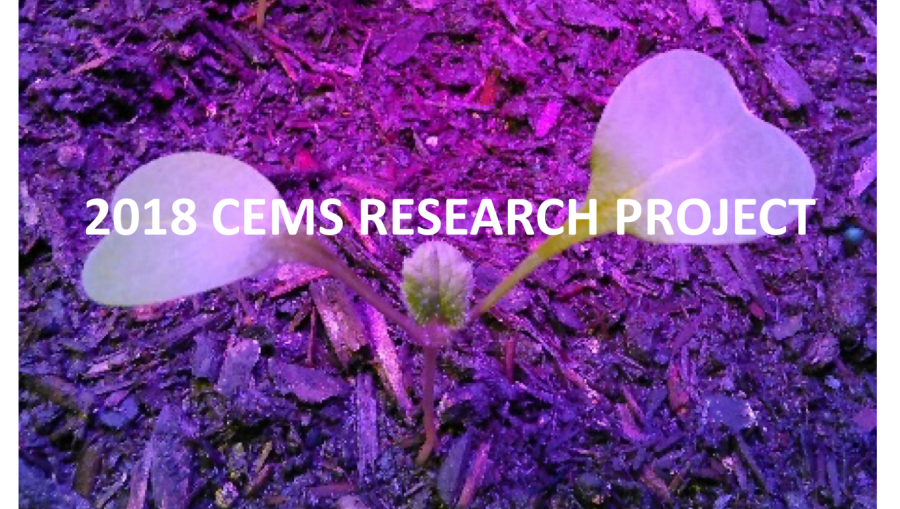2018 CEMS Research Project: Radishes grown with hydro-mechanical irrigation
April 22, 2018
During their high school careers, many students dread group projects. For them, a month-long group project would sound like a nightmare. But the reality for students in the CEMS program is that they must survive a year-long group project in which they must design a product to solve a real-world problem.
In their senior year, CEMS students have a cumulative senior year capstone project, completed in a three-trimester long class, PLTW Engineering Design and Development. They rely on their experiences from their past three years in the program. From them, they have learned skills like 3D modeling, calculating, and coding, to public speaking and learning to cooperate in groups, which they utilize for the project.
Now, nearing the end of completion of their project is a group of five seniors: Sarah Belka, Lindsey Anderson, Jordan Anderson, Casey Fortman, and Max Gudmunsen. In Blueprint’s interview with Belka, we were allowed a close-up look at their process.
In the first trimester, the first order of business was to choose groups with 5-6 members. Students completed various personality type quizzes to see who they would be most compatible working with. Having different types of personalities in a group was optimal, as more similar types tended to clash.
“Realize who you are picking. You will be with them for the entire year, so don’t choose to be with leeches or micro-organizers,” said Belka. Even though it may seem tempting, she said, “Don’t choose to work with your close friends.”
Instead, she suggested that when choosing group members, their skill set should also be taken into account. She identified people with heavy experience in welding, circuits, code, wood and metal shop, and other skills used to manufacture as “do-ers.” People with the ability to think through problems and come up with creative ideas she called “thinkers.”
Belka said, “Most of our group were ‘thinkers,’ so bringing our design to life was difficult.” They had many creative designs but had to keep in mind that they could only choose one that they could actually build. “Having a balance of both ‘thinkers’ and ‘do-ers’ is best,” she said.
Next, the groups needed to settle on a problem. “Our group was like-minded when settling on an issue. We all wanted our project to help the environment,” Belka said. After debating about deforestation, and ocean acidification they decided on water and energy conservation in irrigation.
“70% of our freshwater is used in agriculture, and 75% of that is wasted, meaning it doesn’t reach the root of the plant,” Belka explained the importance of their issue. She continued, “The US has already been having issues with drought like in California.” But this is just the beginning. Under the Great Plains, the Ogallala Aquifer is depleting faster than it can be replenished.
Belka said, “Within our lifetimes the aquifer will go dry. We wanted to do something before it’s too late.”
They also selected an irrigation expert to be their mentor through their process.
Their second trimester was spent designing their solution. Each member had to create ten different design plans. Belka advised for groups to focus on clear communication during the process of selecting and refining the design. She said, “It’s often hard to understand other group member’s visions: how they want the final project to look like when built.”
The process of choosing designs made Belka realize that being a negotiator was crucial for getting things accomplished.
Third trimester, their priority was making and testing their prototype, initially built from simple cardboard. Their final engineered irrigation system is made from PVC pipes. Inside, as the water rushes through, it turns 3D printed plastic turbines that provide the force to move the entire unit. “Our irrigation system is fuel-efficient, powered by hydro-mechanical energy, and it delivers the water directly to the plant, incorporating water efficiency into our design,” said Belka.
Belka’s group recently talked with professors from California Polytechnic State University in a teleconference. She said, “We learned about hydrodynamics and truly efficient systems and discovered flaws in our design we didn’t realize before.” They also discussed how effective their design would be in the real world, and if farmers would be willing to invest in it.

Currently, the team is testing their prototype and putting on finishing touches. They have been successfully growing radishes, which they hope to harvest before their final presentation of their design on Saturday, May 19th. At their booth, they plan to have radish chips made from radishes grown with a hydro-mechanically powered irrigation system.
Belka had some final advice for future seniors in the CEMS program: “Don’t choose a dumb problem.” She alluded to a group in the past who had designed cat sweaters.
The seniors are able to patent their design, owning their ideas. Later, they could return and refine their product and even end up selling it and transform the industry, as one team in the past had made a medical device that changed treatment for patients.
Belka said, “Realize you can make an impact.”



